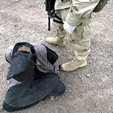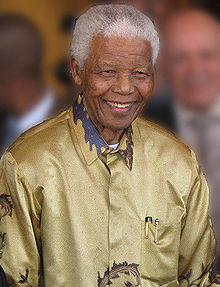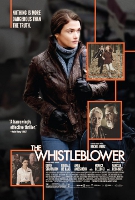Folterskandal auch in Afghanistan
 Die erschreckenden Vorkommnisse im irakischen Gefängnis Abu Ghraib haben System. Mitglieder der A Kompanie des 519th Military Intelligence Battalion aus Fort Bragg, waren auch in Afghanistan im Foltereinsatz. Ihre Brutalität kostete auf der Air Force Base in der Stadt Bagram im Dezember 2002 zumindest zwei afghanischen Gefangenen das Leben – Mullah Habibullah und einen Mann namens Dilawar. Sie starben Tage später in ihren Einzelzellen an den Folgen der Folter. Das berichteten am Samstag die beiden Zeitungen New York Times und Washington Post unter Berufung auf einen noch nicht veröffentlichten Untersuchungsbericht der US-Armee.
Die erschreckenden Vorkommnisse im irakischen Gefängnis Abu Ghraib haben System. Mitglieder der A Kompanie des 519th Military Intelligence Battalion aus Fort Bragg, waren auch in Afghanistan im Foltereinsatz. Ihre Brutalität kostete auf der Air Force Base in der Stadt Bagram im Dezember 2002 zumindest zwei afghanischen Gefangenen das Leben – Mullah Habibullah und einen Mann namens Dilawar. Sie starben Tage später in ihren Einzelzellen an den Folgen der Folter. Das berichteten am Samstag die beiden Zeitungen New York Times und Washington Post unter Berufung auf einen noch nicht veröffentlichten Untersuchungsbericht der US-Armee. 28 amerikanische Soldaten sind demnach in den Skandal verwickelt. Doch nur gegen zwei wurde bisher Anklage erhoben. Einer davon ist Willie V. Brand. Er hat "Mr. Dilawar", wie es in den Akten heißt, an der Decke aufgehängt, getreten und geschlagen. Mindestens 37-mal. Fünf Tage lang, gnadenlos. So zerschmetterte er Dilawar die Kniescheiben. Am 04. Dezember starb er in der Isolationszelle. Hätte er überlebt, "hätten beide Beine amputiert werden müssen", wird ein Mediziner im Armeebericht zitiert. Bisher hatten US-Offiziere in offiziellen Stellungnahmen beteuert, die afghanischen Gefangenen seien eines "natürlichen Todes" gestorben.
Im Juli 2003 kam die Einheit der 519th unter Captain Carolyn Wood nach Abu Ghraib. Die A Kompanie der 519th ist auf Verhöre spezialisiert. Sie spielte offensichtlich eine Schlüsselrolle: Es heißt, sie habe die aggressiven Verhörtechniken aus Afghanistan „mitgebracht“. Captain Wood entwarf mehrere Verhör-Regeln, die dann im Irak angewandt wurden. Diese sogenannten „Rules of Engagements“ wurden im Oktober im Gefängnis von Abu Ghraib bekannt gegeben. Danach gab es zum einen Verhör-Prozeduren, die bei allen Gefangenen angewandt werden konnten, und zum anderen Methoden, die nur mit ausdrücklicher Billigung von General Sanchez eingesetzt werden durften. Somit verdichten sich die Hinweise, dass Angehörige des Militärgeheimdienstes in den Folterskandal verwickelt sind.
Weiterführende Artikel:
Abu Ghraib Time Line
By Melissa Cirillo & Sherry Ricchiardi of AJR
October 7, 2001
The war in Afghanistan begins.
December 26, 2002
The Washington Post runs a page-one story about prisoner abuse at secret CIA detention centers, including in the "forbidden zone" of the U.S.-occupied Bagram air base in Afghanistan.
March 20, 2003 The war in Iraq begins.
March 31, 2003
The Nation's cover story, "In Torture We Trust?" asserts that torture is gaining mainstream acceptance in the age of 9/11.
May 17, 2003
The New York Times publishes a story out of Basra, Iraq, in which detainees claim they were abused by U.S. and British soldiers. Amnesty International investigators say the patterns of mistreatment may constitute torture.
August 18, 2003
The Los Angeles Times spotlights four Army reservists from Pennsylvania, part of the 320th Reserve Military Police Battalion, charged with mistreating and beating Iraqi POWs.
October-December 2003
Many of the alleged abuses at Abu Ghraib take place.
October 5, 2003
The Associated Press reports on the closure of Camp Cropper, a notorious detention center at the Baghdad airport. Journalists had been barred from the camp, but reporter Charles J. Hanley interviews released detainees about abuses.
November 1, 2003
The AP distributes a major story by Hanley about alleged abuse at three Iraqi POW camps, including Abu Ghraib, based on interviews with former POWs.
January 13, 2004 Army Spc. Joseph M. Darby, an MP at Abu Ghraib, reports cases of abuse at the
prison to military investigators.
January 16, 2004
The U.S. Command in Baghdad issues a one-paragraph press release about an investigation into prisoner abuse. A Lexis-Nexis search shows that most media outlets either ignored the announcement or ran brief stories.
January 19, 2004
Lt. Gen. Ricardo Sanchez orders a criminal investigation into the 800th Military Police Brigade.
January 21, 2004
CNN reports that U.S. male and female soldiers reportedly posed for photos with partially unclothed Iraqi prisoners and that the focus of the Army's investigation is Abu Ghraib.
January 31, 2004
Maj. Gen. Antonio M. Taguba is appointed to head an inquiry into allegations of abuse at Abu Ghraib. On March 3 he presents his report, citing widespread abuse of prisoners by military police and military intelligence officers, to Gen. David McKiernan. On April 6 McKiernan approves the findings, leading to the discharge of two soldiers from the 800th MP Unit and letters of reprimand to six others.
February 23, 2004
The U.S. military announces that 17 personnel have been relieved of duty during the abuse investigation.
March 3, 2004
Jen Banbury, a correspondent for the online magazine Salon, files a story out of Baghdad about allegations of beatings, sleep deprivation, sexual humiliation and neglect leading to deaths at Abu Ghraib.
March 20, 2004
Brig. Gen. Mark Kimmitt announces to the media that six military personnel have been charged with criminal offenses. On May 7, a seventh soldier is charged.
April 28, 2004
CBS' "60 Minutes II" airs graphic photographs of abuse at Abu Ghraib. The scandal quickly becomes major national and international news.
April 30, 2004
The New Yorker posts on its Web site a detailed report on Abu Ghraib by Seymour M. Hersh, fueling the media frenzy. The article is published in the magazine's May 10 issue. Hersh follows up on the burgeoning scandal in the next two issues.
sfux - 13. Mär, 11:13 Article 4474x read
















































